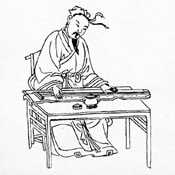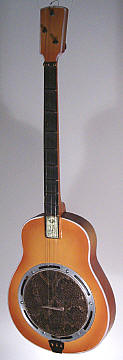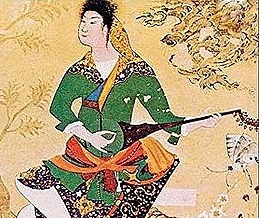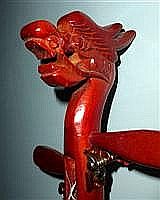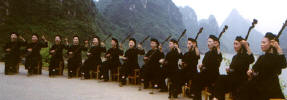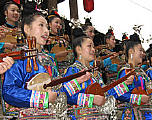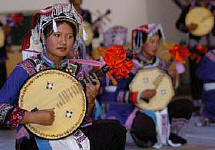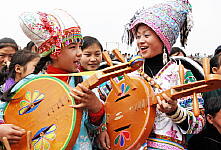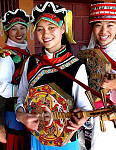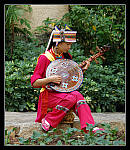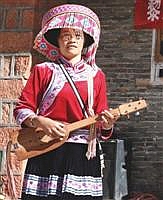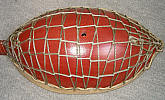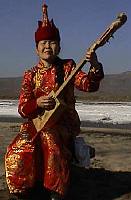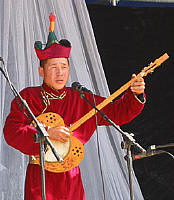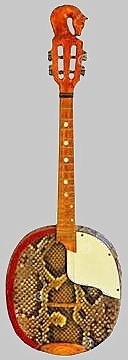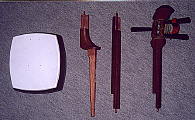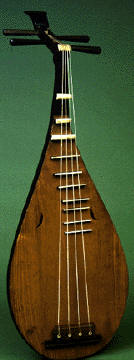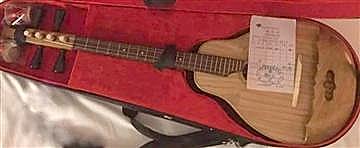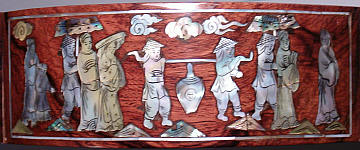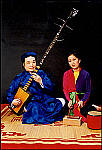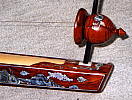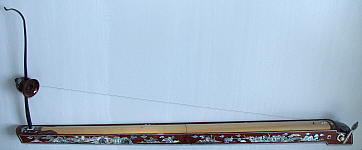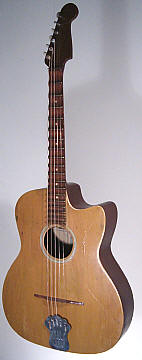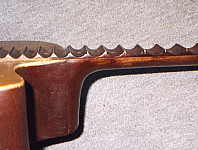| Far East | ATLAS of Plucked Instruments |
| •
HOME • about • collection • books • index • links • lutes • guitars early • guitars modern • mandolins • cittern • banjos • steelguitars • miscellaneous • Europe West • Europe East • Europe South • Africa • Middle East • Central Asia • India • Far East • S.E. Asia • America N • America C • America S
|
Far East This is a long page. Most of the plucked instruments of the Far East look quite similar, clearly originating from a single (Chinese) source. Even the names are often quite similar, although usually
you can distinguish (by small differences) the instruments from each
particular country or region.
|
| top | China | |||||||||||
|
pipa
The pipa is the main lute
of China. Old pictures show it must have been known for more than 2000
years; it is still the most popular plucked instrument. See under for
other types of pipa. The name comes from the finger movement
: pi (= play forward) and pa (= play backward). The peghead is sickle-shaped and ends in a curl to the
front, with a special Chinese type decoration of different woods. The
four long grooved friction pegs (ending with slices of different woods)
are with two on both sides of the open peghead. The four silk (Or steel)
strings are fixed to a nicely shaped bamboo bridge, glued to the front.
There is no soundhole, except one tiny hole under the bridge. The pipa used to be played with bare fingers, although since the original silk string are replaced by steel strings (for more volume) it is played with nail picks, taped to the thumb and all fingers, or with a plectrum. It is usually played in an upright position with the body resting on the left thigh. The picking direction is opposite that of guitar-playing : the fingers flick out and the thumb pulls up (nail first). Often a mandoline-like tremelo is used, by playing "rolls" with alternating fingers. The music is (for centuries) written in special tablature,
indicating string, fret position, finger, direction, volume, etc. The
pipa is used in all Chinese orchestras for accompaniment, but
there are many solo pieces, usually reflecting some mood, or celebrating
some historical happening (often some battle). |
|||||||||||
| top |
|
|||||||||||
|
ruan The ruan is the Chinese "mandolin". It comes in several sizes : gaoyinruan (soprano), xiaoruan (alto), zhongruan (tenor), daruan (bass) and diyinruan (contrabass). Only the zhongruan (tenor) and daruan (bass) are commonly used in Chinese orchestras. The body of the ruan is made from two round pieces of soft wood of about 30 cm diameter for front and back, with a shallow rim of hardwood around them. Usually there are two soundholes (round or other shape) on the front. The neck is joined to the body, and has a raised fretboard. The peghead is sickle-shaped and ends in a curl to the front, with a special Chinese type of decoration, made of different woods. The frets are small strips of bamboo (or plastic), glued on the fretboard, in a normal western scale (12 frets to an octave). The 4 long (grooved) friction pegs are placed two on
each side of the pegbox. They have an invisible tuning mechanism inside
the peghead, which turns the pin on the front of the closed peghead.
The ruan is played with a plectrum. With sizes ranging from large, medium to small, the modern ruan is capable of producing a variety of tones that range from rich to delicate. It is often used in orchestral performances, as well as for accompaniment of folk operas.
|
|||||||||||
| top |
|
|||||||||||
|
yueqin
/ yueh qin The yueqin (or yueh qin, or yueh chin) is the Chinese "moon-guitar" and looks quite similar to the ruan. For the different yueqin from the minorities and from Taiwan see under. For the similar Japanese Gekkin see Japan. The body of the yueqin is made from two round
pieces of soft wood of about 30 cm diameter, for front and back, with
a shallow rim of bended hardwood around them (thinner than the ruan).
There is only one tiny sound hole under the bridge. The 4 silk (or nylon or metal) strings are fixed to
a (half round) hardwood bridge which is glued to the front. The yueqin is played with a long plectrum, in mandolin-style. |
|||||||||||
| top |
|
|||||||||||
|
liuqin
The liuqin (pronunciation: Lee-oo-chin) or liuyeqin, is the small relative of the pipa. It's name derives from the fact that it looks like a willow leaf (ye is leaf, liu is Chinese for "willow"). It would originally have been made of willow too, but new models are made of tong and sandal wood. The example instrument is a modern, cheaper version where everything black is made of black plastic. In general the liuqin is made like the pipa. So the body, neck and pegbox are carved from one piece of hardwood, and painted black. The front is made from some softwood. All frets are made from strips of bamboo and in a normal western scale. Usually there are two soundholes next to the strings on the front, each covered with an ivory (now always plastic) pierced rosette. The pegbox is sickle-shaped with a forward curl that ends with a special decoration of different woods/plastics. It has 4 long grooved wooden pegs, two on each side of the open pegbox. The 4 steel strings run over a small (rounded) bamboo bridge to some pins on the edge of the body. The tuning is g d' g' d''. The liuqin is played with a plectrum, and is mainly used in the accompaniment of folk operas, although quite often it can be heard as a solo instrument. Because of its shorter strings & relatively small resonator, the liuqin is noted for high pitches and distinctively bright tones.
|
|||||||||||
| top | ||||||||||||
The frets on the example are made from turtle-like plastic. |
nanyin
pipa Besides the normal pipa there is an other style pipa, called the nanyin pipa, (or short : nanpa) or "Nanguan pipa" ("southern pipa") or sometimes "horizontally held pipa". It is mainly used in the Fujian region (South East) and on Taiwan. The body is more or less the same as the normal pipa,
the main differences are the frets, the pegbox and the black coloured
soundboard. The nanyin pipa has only 4 triangular frets (instead of the 6 of the normal pipa, missing the lowest and the top one), made of triangular pieces of wood, covered with sea turtle shell. The 10 lower frets are made of the same thin material and in a diatonic scale. The fingerboard on both sides of the triangular frets is covered with mother-of-pearl.
Nanyin is a traditional opera sung
in the Minnan (south Fujian) dialect. Closely tied with imperial and
Buddhist music, poetic rhythm and drama tunes from Central China, Nanyin
is accompanied by a band of erxian (fiddle), sanxian,
dongxiao (flute), nanpa (bent-neck pipa) and paiban
(clappers). |
|||||||||||
| top |
|
|
sanxian The sanxian (or san-hsien, which literally means
"three strings" in Chinese) is a popular Chinese banjo.
The body of the sanxian is made from a hoop
of hardwood, with on front and back the skin of a snake (python), glued
all around the edge of the rounded hoop. Tuning could be : G d g or : G c g. The sanxian is usually played with thumb and finger plectrums. With a strong, rich tone and a wide range, it is used in accompaniment as well as orchestral and solo performances. The big sanxian (which has a less sharp sound) is mainly used to accompany songs. The example instrument (with the small body) has a special wooden capodastre on the neck, through which all 3 strings go; by sliding this up and down the neck the easiest range for the singer can be found, without re-tuning. |
|||||||||||||||||
| top | ||||||||||||||||||
|
guqin/ ku chin The qin or guqin (or old spelling chin or guchin) is a seven string fretless zither, and one of the oldest instruments. Because it was played by the higher classes it was also known as the "lute" of China. In Chinese, "gu" means "old", and "qin" means "musical instrument". So although it was historically known as CHIN, during the last century is has been widely called GUCHIN. The body of the guqin is made from a big plank of hardwood (of about 1.20 meter), hollowed out from the back. The bottom is covered with a flat plank. The entire body is painted with black lacquer. In the bottom plank is a long slit (soundhole), which is covered on the inside with half a bamboo pole. Is has two round "feet" at the left side. The 7 silk strings are fixed on the right side to pegs that can be twisted (and therefore tuning the strings) from the bottom up. The strings run to a small bone bridge at the left end of the soundbox, and are then fixed at the bottom to some tuning device near the feet. The seven strings can be tuned in a variety of keys, but the basic tuning is: C D F G A c d. On the far side of the top string (the thickest, furthest from the player) are 13 white dots to indicate the flageolet points. The guqin is played by laying it flat on a table and plucking it with the right hand. The left hand shortens the strings (more or less holding the thumb sideways) by pressing the string down on the soundboard - often sliding up and down. Also a variety of flageolets can be produced. Because of this technic of shortening the strings, it is the only zither included here on the website. Maybe there are thousands of chin pieces in existence, some from 500 AD and many of these pieces are still played today. The music is in tablature, which gives detailed information about place, string, finger, direction, volume, etc.
|
|||||||||||||||||
| top | ||||||||||||||||||
|
qinqin The qinqin (or chinchin, but same pronounciation) is a plucked instrument mainly used in folk music in South China. The qinqin can be found with several body shapes
:
|
|||||||||||||||||
|
shuangqing The shuangqing (or shuangqin) is an
instrument that is related to the qinqin, but is longer, has
4 strings in two pairs, and has an octagonal body.
The neck has 13 high white bone (or ivory) frets in a scale of 7 (more or less) equal intervals for an octave. The 4 long grooved friction pegs are cone shaped, and
placed two on each side of the open pegbox. The shuangqing is played with a plectrum. |
|||||||||||||||||
| top | Chinese minorities | |||||||||||||||||
|
sugudu
The body and neck of a sugudu is made from one piece of wood. The body shape slowly tapers to the top, and then goes over with vague "points" to the narrow neck. The lower part (a circle) is hollowed out, and covered with skin (now often python snake, but also goat was used). There is a narrow slit along the top of the skin. Halfway the neck are some decorated small "soundholes" in the front - probably originally the top half of the body was also hollowed out and covered with a thin piece of wood. The neck is long and fretless, and ends with a straight
peghead, which maybe is slightly slanting to the back. The peghead is
half open on the back. The sugudu is used for playing in a small group (with flutes, 2-string fiddles, pipa and sanxian) or in large orchestras. For more information see : sugudu. |
|||||||||||||||||
| top | ||||||||||||||||||
|
huobusi This new guitar-type instrument is loosely based on the
sugundu (see above) and named huobusi (or huobosi
- all meaning "musical instrument"). The body of this huobusi is made like a guitar, but the (quite thick) front and back are slightly overhanging the sides. The bottom half follows the roundings of a normal guitar, but the top half has sharper curves. The soundholes on both sides of the bridge are decorative holes in a vague f-style. There are decorative black/white painted curly lines on the front, around the edges on the top half and along the bottom half.
The thick fretboard has metal frets, and the long part over the soundboard is free from it. The 4 steel strings run over a large loose wooden bridge to holes in an extension on the bottom of the body. Tuning could be similar to the sugudu : A d
g c, or like the pipa : A c d a, or ?. |
|||||||||||||||||
| top | ||||||||||||||||||
|
naxi pipa The Naxi people in Yunnan (Southwest
China) use a type of pipa that seems similar to the normal
mainstream Chinese pipa, but is older and different. It may
also be called the pear-shaped pipa. The tuninghead is open and has four large round tuningpegs
: two on each side.
|
|||||||||||||||||
| top | ||||||||||||||||||
|
tianqin The tianqin is popular amongst the Zhuang people. It looks very much like the dan tinh from Vietnam (see under) - the main difference is the peghead. Most of the Zhuangs live in southwest China's Guangxi Zhuang Autonomous Region. The Bupian people call it dingding.
The two or three silk (or nylon) strings run over a small loose wooden bridge to the end of the neck that sticks out of the body. Often it has a special device fixed as stringholder. Tuning could be : (G) d g.
|
|||||||||||||||||
| top | ||||||||||||||||||
|
dong pipa The dong pipa is popular amongst the Dong people. It resembles the sung from Thailand (see page South East Asia). The Dong minority live in southwest China's Guangxi Zhuang Autonomous Region and Guizhou Province, as well as in south China's Hunan and Hubei provinces. The body (and first part of the neck) of the dong
pipa is made from one piece of wood, hollowed out from the front.
The soundboard is a piece of wood glued on the front. The body may be
in the shape of a heart, a square or a bit rounded. The neck with the
pegbox is made from another piece of wood, and joined halfway the neck
to the body. It usually resembles the neck of a sanxien (China)
or shamisen (Japan). It has 2 or 3 inlayed metal frets. In
general the instrument will look a bit rustic.
|
|||||||||||||||||
| top | ||||||||||||||||||
|
yueqin of the Yi minority The Yi ethnic minority uses a yueqin (moon-guitar), which is quite similar to the one used by the Han Chinese. However they call it : xianzi, kuzhu or sixian. The difference with the yueqin is mainly in decorations and soundholes, but sometimes also the body size, shape and the number of strings.
|
|||||||||||||||||
| top | ||||||||||||||||||
|
qiben The people of the Lisu tribe in Yunnan province in Southwest China use a lute-like instrument called qiben (or qibue). It comes in different sizes.
The tuning head is often in a slight curve. The top end
may have some wood carving. The half open pegbox has four long round
pegs : two on each side. Some tuning heads may be flat with guitar tuners. Tuning could be: d f g a, but there are more. |
|||||||||||||||||
| top | ||||||||||||||||||
|
sixian The Pumi people use a lute-like instrument called sixian, or yangtou qin ("sheep's head lute"). The Pumi is a small ethnic group that live in the mountainous area of Yunnan Province in Southwest China, near the town of Lanping.
The tuninghead is separate from the neck, and half open,
with on both sides two big round friction pegs (or nowadays guitar-tuners).
The tuning head ends in a rather big carved head of a sheep, showing
a stylised ear and horn on both sides. The entire instrument is varnished. |
|||||||||||||||||
| top | ||||||||||||||||||
|
yueqin taiwan In South China and on the island Taiwan they use a special type of yueqin. This instrument looks like a hybrid of several Chinese plucked instruments : the round body of a yueqin, the neck with the frets of a pipa, the tuning head of a sanxian and the size of a ruan ! But note that (like the ruan) there are different sizes. The flat round body of this yueqin is made
of wood (back and side), with a thin piece of unvarnished soft wood
glued to the front, on top of the sides. The neck and pegbox are made
from another piece of wood. The frets are made of bamboo wood and in
a diatonic (western) scale, with the first four frets made of triangular
pieces, and the rest of thin high pieces. It has a small round soundhole
under the bridge. The yueqin is played by strumming both strings with a plectrum (or finger), but only the first one is fingered. It is mainly used to accompany singing, or in small instrumental groups. In Taiwan it seems very popular with schoolchildren. |
| Mongolia | ||||||||||||
|
tobshuur
(inner Mongolia, China) In the Chinese Province of Inner Mongolia they use a fretless tobshuur (or tovshur) that looks very much like the well known cello of the Mongolians, the Morin Khuur. It seems made in a factory. The body is built like a guitar, with some soft
wood front. The body shape is usually quite rectangular, or bottle shape
- it may vary between makers. The back, sides and neck are painted.
The sound holes could be like two f-holes or just
a single round hole. The decoration lines near the edge and the Mongolian
signs are painted on the wood. The tobshuur is strummed with the right finger (or a plectrum) and often only the first string is fingered (and the second with the thumb). It is mainly used to accompany throat singing.
|
|||||||||||
| top |
|
|||||||||||
|
tobshuur
(Mongolia - the state) In Mongolia (the country) the tobshuur has a different shape. Although it used to be made with a skin top (like a banjo), nowadays they have changed to wooden tops for more volume. Also quite recently the idea of a swan has turned up. On CD's of Mongolian music these instruments are now often called "swan-neck-lutes". On the example the idea of the swan is not only used for the shape of the head, but also for the two sound-holes (cut in the front), and the carving on the back of the body. The instrument resembles much the bowed-lute igli from Tuva, which has a skin front and a horsehead peghead. The body of this tobshuur is carved from one piece of wood. The back has some carving in the shape of two wings. The neck is joined to the body and is, together with the peghead, made of one piece of wood. The peghead has a carving of a swan head. The eyes and the beack are painted. The fretless neck is flush with the soundboard and has no fingerboard (the black is painted on). The tobshuur has two (nowadays nylon) strings, tuned with a round wooden tuning peg on each side of the (open on the back) pegbox. The strings go through holes near the nut to the back. The strings go over a rather big loose wooden bridge, and are fixed to a wooden pin at the end of the body. The tobshuur is strummed with the right finger and often only the first string is fingered (or the second with the thumb). It is mainly used to accompany singing.
|
|||||||||||
| top | ||||||||||||
|
topshur
/ khomys (Russian Federation) This is another tobshuur or as it is called in the Russian Federation : topshur or khomys. It looks more like the traditional tobshuur, as it has a skin front. So it also looks like the Tuva bowed-lute igli. The body of the topshur is carved from a solid block of wood in a smooth oval shape, and a small round soundhole in middle of the the back. The leather skin is not glued, but stretched by means of many pieces of (nylon) rope all around the back of the wooden body. In the skin are three small decoration holes. The neck and (square) peghead are made from a separate piece of wood. All the wood is painted dark brown. The topshur has two nylon (guitar) strings, which are tuned by a round wooden peg on each side of the (open on the back) pegbox. The strings go passed a plastic nut through small holes to the back. At the other end they run over a rather big loose wooden bridge to a small wooden pin at the end of the body. The neck is not rounded, but five-sided and slightly raised above the skin; it has no fret board. The frets are in western scale, and are made of wound nylon, but in one long binding, so all frets are joined. The topshur is strummed with the right finger and often only the first string is fingered. It is mainly used to accompany singing.
|
|||||||||||
| top | ||||||||||||
|
shanz / shudraga
This instrument is in fact the same as the large size Chinese sanxian (see above), which is also popular in the Mongolian area, but here it is called shanz or shanza or shudraga. The shanz has strings of nylon instead of the
often used metal strings for the sanxian. The shanz is mainly used to accompany singing, and for "classical" music. Nowadays it seems also very populair in Mongolian popmusic.
|
|||||||||||
| top | Tuva | |||||||||||
|
doshpuluur
In Tuva (a small republic of the Russian Federation, just north-west of Mongolia) they use a kind of plucked instrument which is quite similar to the tobshuur, but called doshpuluur (also spelled : toshpulur, tochpuluur, dospulur, etc.) The doshpuluur is a kind of banjo, but usually with the body in the shape of a rectangle. The wooden sides are covered on both sides with goatskin. Sometimes (pine) wood is used for the soundboard. The skin is folded over at the top and on sides and bottom joined together with a leather rope. The (pine wood) neck (with the tuning head) is long and
goes straight through the entire body. Some instruments have a few frets,
but normally the neck is fretless. Nowadays the three strings are metal wound (guitar)
strings.
|
|||||||||||
| top | ||||||||||||
|
chanzy In Tuva they use a second kind of plucked instrument, which is quite similar to the shudraga and called the chanzy (also seen : chanzi and tyanzi). It is regarded as a special shaped doshpuluur. The chanzy is a kind of (round) banjo, with a (goat or snake) skin glued on the front of a round wooden hoop. It has some decorative wooden box around it (made of triplex), in a kind of heart shape (some call it kidney-shape). Usually it has two similar soundholes and some painted decoration. The example instrument has a Ying-Yang shaped black plastic scratchplate glued to the skin.
|
|||||||||||
| top | Buryat | |||||||||||
|
chanza In Buryat (a republic of the Russian Federation near Lake Baikal in Siberia) they use besides the large Mongolian shanz (see above), a smaller instrument called chanza (or shanza). This instrument seems a combination of a shanz body with a mandolin neck. They come in several sizes : primo, alto, and tenor. As bass the large three string shanz is used. The body of the chanza is an oval wooden hoop, with a flat wooden back. The front has a python skin glued to it, while the cheaper student chanza may have a goatskin. Often a plastic scratch plate is fixed over the (right) top half of the front. Sometimes an octagonal box is surrounding the oval body. The neck is separate, with the fretted fingerboard running a few centimeters over the front. The tuning head is either double slotted (with two mechanical tuners on both sides) or flat with tuners from the back. The top of the tuning head often has a decoration of a horse head looking sideways, or it has a symmetrical end. The four metal strings run over a small wooden bridge
on the skin to a string holder at the edge of the body. The chanza is played with a plectrum (balalaika-style,
with lots of tremelo) and mainly used to accompany singing, and for
"classical" music. Note that in Tuva they use an instrument called chanzy,
and in Mongolia another one called shanz. |
| top | Japan | ||||||||||||||||||
|
biwa The biwa is the Japanese lute, and looks much like its predecessor - the Chinese pipa. However it is quite differently played and the sound is also completely different. There exist several types of biwa, which differ in size and tuning, like the gaku biwa, the chikuzen biwa and the satsuma biwa. For more information see Biwa and Taiko-center. The body of the biwa is carved from one piece of hardwood, with a thin softwood soundboard, slightly rounded. This has two half moon shaped soundholes, with bone inlay around them. The back has vague carvings, like glued-on papers. The neck is part of the body (although on the example both the neck and the pegbox can be taken separate). The 5 (or 4) high frets (and the top bridge) are made from small "piles" of different woods, with a rounded top. The pegbox is square and bends backwards, ending in a kind of upwards curl. The 4 (or 5) silk strings are tuned with long round wooden tuning pegs, 2 on each side of the open bexbox. They are fixed to the bridge, which is a carved piece of wood glued to the front, and has bone (?) decoration on the sides and around the string fixing holes.
As biwas are rarely made anymore, you are lucky to find one - the example instrument had burn marks on the front, and missed the pegs and one fret, which are replaced by some look-alikes. |
||||||||||||||||||
|
shamisen The shamisen (or samisen or jamisen) is the most well known Japanese plucked instrument, which arrived around the 16th C in mainland Japan via the Chinese sanxian and the Okinawa sanshin. Both predecessors used python snake as skin, but for some reason (probably the lack of snake skin) the Japanese started using the skin of dog, or cat (which is more expensive because you can get less skin from one cat...). Nowadays often a synthetic skin is used, like on western banjos. Putting on a skin at the very high tension that is required, is work for specialists. As is the woodwork : the neck is made of 3 pieces which fit together (with special lips and holes) so tightly that you can hardly see the joins. The body of the shamisen is made from 4 pieces
of hardwood, joined so they make an almost square hoop. On front and
back a white skin is glued.
The 3 strings run over a loose small, neatly carved bamboo bridge, and are tied to 3 coloured silk ropes. These are fixed to the end of the neck sticking through the body. Tuning can be : C F c (honchoushi), C G c (niagari), C F Bmol (sansagari).
Transporting the shamisen is easy : by slightly loosening the strings, the coloured ropes come loose from the endpin and the strings can be wound around the pegs, the neck taken in pieces and the entire shamisen fits in a small bag. The shamisen comes in slightly different sizes
: nagauta, tsugaru, and jiuta
- the main difference is the thickness of the neck. For more information see Shamisen. |
||||||||||||||||||
|
sanshin The sanshin is a kind of banjo, like the Chinese sanxian (where the name seems to come from) and its close relative : the Japanese shamisen. It is the "national" instrument of Okinawa - one of the Japanese islands in the South.
The 3 nylon strings are tuned with 3 long round wooden
pegs (often black with white endings), 2 on the right and one on the
left of the open pegbox. The strings run over a small loose plastic
bridge to a decorative piece of rope-knot which is hooked on a wooden
pin at the bottom of the body (the end of the neck). Around the body
is a piece of cloth, with embroidery with special Okinawa decoration
patterns.
On the islands of Amami (between mainland Japan and Okinawa) the same sanshin is played, but with a pick made of a long thinly shaved bamboo stem. At the end of WorldWarII materials were scarce and the body was made of empty milk tins : these simple instruments are now again available : the kankara sanshin.
|
||||||||||||||||||
| top | |||||||||||||||||||
|
gottan The gottan is a shamisen made completely out of wood - usually of Japanese cedar. Other names are hako shamisen or ita shamisen. It is mainly populair in the south of Kyushu (Kagoshima and Miyazaki). The body of the gottan is made from four pieces
of wood, glued together to form more or less a square. Some are shaped
to have more rounded sides. The gottan is played with a normal small plastic plectrum, to accompany folk songs.
|
||||||||||||||||||
| top | |||||||||||||||||||
|
gekkin The gekkin is the close relative of the Chinese yueqin, and nowadays the instrument is not made in Japan anymore : all instruments these days come from China, and are in fact normal yueqin (see China). The old gekkin (made in Japan) was almost the
same as the modern yueqin : so also two circles of softwood
for soundboard and back, but now glued on top of the narrow strip of
hardwood for the sides. Inside the body is a long circular piece of
wire that makes a jingling sound when the instruments is shaken/played. The gekkin is played with a long thin plectrum
to accompany Chinese folksongs, but the instrument is not often used
anymore. |
||||||||||||||||||
|
taishogoto It may be a surprise to find the simple folk-like Indian bulbul tarang (see India) to be quite popular in Japan, where it is called taishogoto (also spelled: taisho-koto). Maybe this is the reason why this instrument is often called "Japanese Banjo". Some instruments are electric and even have electronic devices attached to it. Basically the taishogoto is a long acoustic
sound box, with strings on top (close together), which can be tuned
on the left side, and strummed with a pick on the right side. With the
left hand you can press typewriter-like keys, which press down small
metal bars on the strings, and work as frets (although there are real
frets as well). The taishogoto is usually played by large groups of women playing together popular music. See more information here : Taishoharp. |
KOREA |
|||||||||||||
|
Korea does not have
many plucked instruments, just a few zithers.
|
||||||||||||
| top | |||||||||||||
|
komungo The komungo (or also called geomungo) is a long zither, quite similar to the Japanese koto or to the Korean gayagum. Although normal zithers are excluded from this website, the komungo is fretted, so several strings can be used for different pitches. The body is usually made from paulownia wood, hollowed out at the bottom like a half tube. The back and both ends are pieces of hardwood. There are 16 fixed frets for the 3 inner strings and 3 movable bridges for the 3 outer strings (which are always played open). Two open strings are on the far side of the player, and one is nearest the player. The high frets are made of hardwood. The 6 silk strings are at the right side of the player fixed to a small piece of wood, and run from underneath through a hole in the body, over the wide nut/bridge to the other side of the zither and are there tied with a special knot to a long silk rope, which is tied to the end of the body. The komungo is played sitting cross-legged with the right side of the instrument on the lap. The strings are not strummed with the fingers, but with a bamboo stick as plectrum. Nevertheless, the sound is quite similar to the koto and kayagum, which are always played with (long) open strings. The hitting of the strings with the stick can sound quite percussive. |
|
oungum The oungum (also spelled : eoeungeum) is an instrument made and found only in North Korea. It is there the national instrument. According to legend it was designed in 1962 by fellow
students of chairman Kim Jong Il and named by him. It is said to be
based on the original hyang bipa. The oungum is played (solo or in an ensemble) with a plectrum, in a mandolin-style, with often lots of tremelo.
|
||||||||||||
| VIETNAM In Vietnam most
instrument resemble quite closely the Chinese ones, some even have similar
names. However some instruments only exist in Vietnam, like the Dan
Day and Dan Bau (DAN means LUTE). |
|||||||||||||
|
dan nguyet / dan kim The Dan Nguyet or Dan Kim is a relative of the Chinese yueqin or ruan, but with a much longer neck and only two strings. The front and back of the body of the Dan Nguyet are made from a round piece of unvarnished soft wood (diameter of about 350 mm). The side is made of bended hardwood, about 60 mm in height. There is no soundhole. The neck is separate, without a fingerboard and glued to the body. The peghead is made from one piece, slightly sickle shaped and ending in a spade-like backward curve. On both sides of the open pegbox is a long rounded tuning
peg, ending with decorative slices of different materials. Often the
Dan Nguet still has holes for 4 pegs, but nowadays only 2 strings
(and pegs) are used. In the past fingernails were used to play Dan Nguyet. Nowadays, they play it with a plastic or tortoise-shell plectrum. Dan Nguyet is used to accompany singing, in ceremonial music and in the traditional orchestra.
|
||||||||||||
|
dan sen The Dan Sen is a slightly smaller instrument than the Dan Nguyet, but is in fact made in the same way. The body of the Dan Sen has the shape of a
flower (with 6 "petals") and two thin nylon strings. Its origin
is the Chinese qinqin (which usually has 3 strings). The side of the body, the bridge, and the neck are highly
decorated with inlay mother-of-pearl. It is only used in the Hat Boi (Traditional Drama) in South Vietnam.
|
||||||||||||
| top | |||||||||||||
|
dan doan The Dan Doan looks very similar to the Chinese yueqin ("moon-guitar"). It is sometimes also called Dan Nhat or Dan Tu. The body of a Dan Doan is made of a long bended strip of hardwood. The almost circular shaped front and back are made of unvarnished softwood. The short neck is separate and is inserted into a square hole in the body. The frets are strips of (rough) bamboo, glued to the neck and soundboard, in a diatonic scale. The open tuning head curls slightly to the back, and has 4 long round tuning pegs (two on each side). The four (sometimes three) nylon single strings run to a half round bridge, glued to the soundboard. There are no sound holes anywhere. It is played with a plectrum.
|
||||||||||||
| top | |||||||||||||
|
dan day The Dan Day is the main lute of the Viet majority. Its literary name is "Vo de cam" or "bottom-less lute". It can be found only in Vietnam. The sound box of a Dan Day has the shape of a trapezium of hardwood with sides of about 28x20 cm, and a depth of about 6 cm. The soundboard is made of unvarnished light softwood.
There are no frets on the top half of the neck, only
lower down are 10 high frets, made of hardwood with a rim of bamboo.
The 3 nylon strings run to a box-shaped bridge, glued to the front.
|
||||||||||||
| top | |||||||||||||
|
dan tam This three-stringed banjo-lute is used by several
ethnic groups in Vietnam. The Viet call it Dan Tam, whereas
the Ha Nhi call it Ta in. The sound box of the Dan Tam
is oval-shaped, with (python) snake skin on the front. In fact the front
is rounded wood, with a small square hole in the middle; the skin seems
to be glued to the rounded edge. Playing is with a plastic plectrum. The tones of the Dan Tam are bright and cheerful. The techniques for the left hand include tremolos, trills, picking, stopping and especially sliding. Full tones, three-quarter tones and quarter-tones can be played. The Dan Tam is often part of an orchestra accompanying Cheo drama.
|
||||||||||||
| top | |||||||||||||
|
dan tyba The Dan Tyba is very similar to the Chinese pipa. The main difference is that the top six frets are not triangular, but just the same high strips of wood that are used for the rest of the frets. The frets are sometimes in a special oriental scale (7 frets in an octave - like the example), but often in a western scale (sometimes omitting a few frets).
The technique for the left hand, which presses the strings, includes glissando, staccato, arpeggio and tremolo. The Dan Tyba music is light and cheerful. The instrument is played solo or as part of an orchestra or a band accompanying the singing of Hue melodies or operas. |
||||||||||||
| top | |||||||||||||
|
dan bau The Dan Bau is a monocord, a very typical Vietnamese instrument, as it is only played here.
The body is basically a large box, made of hardwood,
about a meter long. The bottom is closed with some flat soft wood. The
top is covered with softwood too, but in a slightly concave shape. The way of playing is to lay the Dan Bau on
a table and hold the pole with the left hand. With the right hand the
string is plucked with a long wooden plectrum, and by touching the string
at the same time with the side of the right hand flageolets are produced.
This is quite tricky as there are no visible orientation points to find
the proper spots. However according to legend, the
Dan Bau was traditionally played by blind (!) musicians. By
bending the pole with the left hand a vibrato, sliding sounds and all
notes in between the (few) flageolet notes can be produced. |
||||||||||||
| top | |||||||||||||
|
ghita The ghita (or Dan Ghi-ta) is a remarkable guitar-shaped instrument, but typical of the Vietnamese instruments. It is also called luc huyen cam or vong co guitar (after the music style). The story is that the Vietnamese who emigrated to the
USA in the 1930's were eager to get an instrument that could be played
like their home instruments - when you pluck a thin string between high
frets (like on the Dan Nguyet for instance) you can easily
bend the tone up by pressing a bit harder. To reach that same effect
on a guitar (which was easy to buy in USA) they scraped the
fingerboard between the frets in a scalloped way; the frets were left
in place. (This scalloping is now also used by some western guitarplayers
to ease very fast playing).
The Vong Co guitar is still quite populair in Vietnam, especially for the Vong Co Opera style, and even electric guitars are used, but all with the scalloped fingerboard. See for examples : Saigonstrings. |
||||||||||||
| top | |||||||||||||
|
dan tinh Dan Tinh is a kind of banjo, played by some ethnic groups in north Vietnam. The Tay and Nung calls it Tinh Then, while the Thai ethnic group calls it Tinh Tau ('Tinh' means a lute and 'Tau' means a gourd). It looks identical to the Chinese tianqin. The body of the Dan Tinh is made from a thick, round bottle-gourd of about 20cm diameter. On the back are 6 small soundholes. The front is often made from thin cinnamon wood which is glued in the rim of the cut-off gourd. The neck is made of one piece of some hardwood (often
'Thung muc' or strawberry wood) and goes with a pin through the gourd
and sticks out at the bottom. Traditionally the length of a Tinh lute
is equal to 0.9x the fist’s length of the player (or 75-90 cm).
Experience shows that this length would best fit with the player’s
voice. There are no frets. Dan Tinh has either two or three strings. The two-string Tinh is tuned at a fourth or fifth. The three-string Tinh is the same, with the 3th string tuned an octave lower than the high string. The Dan Tinh is played with a plectrum. Fingering techniques are mainly glissando, slurring, mordent and vibrating. Dan Tinh is used by several ethnic groups to accompany singing. It is normally played by men only, but with the 'Then' of the Tay ethnic group it is played by women only. |
||||||||||||
|
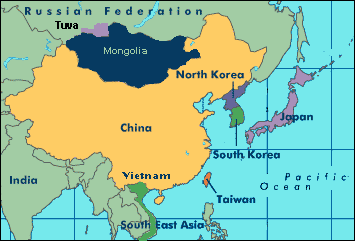

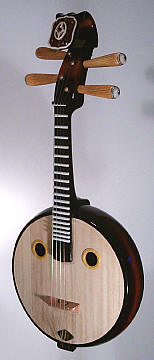
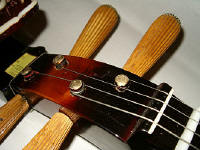

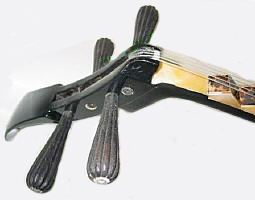
_mz.jpg)


